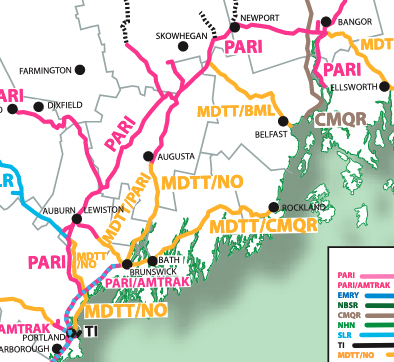
AUGUSTA, Maine — A bill calling for a study to extend rail passenger service from Portland, Maine, to Bangor, via Lewiston, Auburn, and Waterville, was defeated this week in the state’s House of Representatives, CentralMaine.com reports.
In a Wednesday vote, LD 860 was defeated 82-63, a week after the state Senate had approved the legislation by a 23-11 margin. The news site reports that, while the study would have cost only $20,000, and was supported by officials and economic groups on the proposed route, legislators were skeptical of the cost of a project that could exceed $900 million ,and whether the route had the population to support it.
Rep. Dan Ankeles (D-Brunswick) said during floor debate that previous studies have shown there are not enough potential riders to make the route fiscally feasible, and that the funds and effort were better spent on other public transit solutions. Maines Department of Transportation had testified against the bill in a hearing last year.














An unusually smart move by the Maine legislature. Maine is a car centric state due to its rural nature. The Portland to Boston Downeaster works because of the population density. The Brunswick Extension fails because of a lack of a market. The students at the local college are mostly rich kids and daddy supplies the SUVs they drive. Most people I know in Brunswick drive to Portland and board the Downeaster there or take the bus which has a better schedule, is faster and almost never late except at rush hour. Very little market for passenger rail north of Portland. Tourists need their cars to get around. I’m glad the legislature saw that. That money would be better spent on getting freight off the highways and on the rails. The track is in such bad shape from Pan Am deferred maintenance that the $900 million would be only the beginning. CSX would be the only winner in this boondoggle.
The population of Bangor is declining. Unless someone can create a tourist appeal for its spendid architecture, I can’t see any rail helping to save them.
Instea of just looking at population density along the route and in the cities, also take into consideration non-local travelers between those two points…that is where your bread and butter comes from, getting people out of their cars for trips and into other modes of transportation including passenger rail.
Wow!!! 20K for a study. What century am I in? You can’t get a study on the need for a street sign nowadays for less than a million dollars.
Not quite, but close. Street sign studies are cheap; I used to do traffic counts as part of such decisions and on the doing end in my area the man doing such counts worked for $250 for an 11-hour count. Federal rules figured in. Back in 1992 the pay for an all-day count was $70! Big Dig happened. Item: some of those Big Dig counts went unbid and never done and –strangely– never paid either. Water under the bridge as someone might say.
Big federal rules are designed also to determine “worthiness” of projects from the days when federal $$ were scare before the Inflation Reduction Act. May explain why Wilkes-Barre and Scranton can’t get federal $$ to rebuild the Lackawanna & Wyoming Valley interurban. It’s needed–but there are so many little birdies’ mouths to feed and Big Fed Bird gotta choose…
$20,000? Sort of cheap. I’d tell them now there’s a reason those trains quit 1959-60: low ridership! Plus having to service TWO lines: the Lower Road with lots of little stops totalling half the business, and the Back Road with only one BIG stop generating the other half. Expensive to operate TWO routes.
I should send Maine an invoice for $10, make it $20. Make it $200 to cover going on Mass. Bay’s Bangor trip in 1983 which is how I got to know what the routes were like. A lot of open country up there then.
What a crock from the Maine elected officials (from BOTH sides of the aisle…)